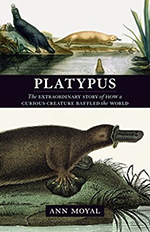29 December 2022
Platypus, by Ann Moyal
Posted by Callan Bentley
 The platypus is extraordinary, and this is a book about how we came to know that. Written by a historian of Australian science, Platypus is subtitled, “The extraordinary story of how a curious creature baffled the world.” Moyal recounts the first specimens being sent back to the intellectual centers of western Europe (London and Paris, principally) from Australia, the subsequent suspicions that it was a hoax of taxidermy, and then the real, slow science that progressed over the ensuing centuries. Once it was shown that the platypus’s bill had a fundamentally different structure from a duck’s, and that this was a real animal, it was time to name it. The most fundamental anatomical detail was the cloaca – the excretory ducts and reproductive anatomy all ended in “one hole” – hence the name Monotremata. It turns out the echidnas had this set-up too, though their life habits and external anatomy were markedly different. (Their taste, too, apparently – Moyal reports that Aboriginal Australians enjoyed eating echidna as a favorite meat, but eschewed the platypus.) Now the big question was: were platypuses oviparous or ovoviviparous? This means – did the females gestate their eggs within their body, or were the eggs laid externally? This question was important – no other mammals beyond the monotremes did either – but it was very difficult to answer, since the female platypuses and their young sequestered themselves out of sight in deep burrow complexes during the critical time. The book delves into the highbrow consternation that plays out in letters sent back and forth between Australian naturalists and heavyweights like Richard Owen and Charles Darwin back in civilization. Honestly, the book probably spends a bit too much time on this period of uncertainty (probably because it left a decades-long paper trail, and what historian can resist all that primary literature?). As a consequence, though, the book short-changes more recent scientific advances in platypus biology, such as the functioning of their amazing snouts as electrical detectors. (Try Ed Yong’s An Immense World for a more detailed write-up of that topic.)
The platypus is extraordinary, and this is a book about how we came to know that. Written by a historian of Australian science, Platypus is subtitled, “The extraordinary story of how a curious creature baffled the world.” Moyal recounts the first specimens being sent back to the intellectual centers of western Europe (London and Paris, principally) from Australia, the subsequent suspicions that it was a hoax of taxidermy, and then the real, slow science that progressed over the ensuing centuries. Once it was shown that the platypus’s bill had a fundamentally different structure from a duck’s, and that this was a real animal, it was time to name it. The most fundamental anatomical detail was the cloaca – the excretory ducts and reproductive anatomy all ended in “one hole” – hence the name Monotremata. It turns out the echidnas had this set-up too, though their life habits and external anatomy were markedly different. (Their taste, too, apparently – Moyal reports that Aboriginal Australians enjoyed eating echidna as a favorite meat, but eschewed the platypus.) Now the big question was: were platypuses oviparous or ovoviviparous? This means – did the females gestate their eggs within their body, or were the eggs laid externally? This question was important – no other mammals beyond the monotremes did either – but it was very difficult to answer, since the female platypuses and their young sequestered themselves out of sight in deep burrow complexes during the critical time. The book delves into the highbrow consternation that plays out in letters sent back and forth between Australian naturalists and heavyweights like Richard Owen and Charles Darwin back in civilization. Honestly, the book probably spends a bit too much time on this period of uncertainty (probably because it left a decades-long paper trail, and what historian can resist all that primary literature?). As a consequence, though, the book short-changes more recent scientific advances in platypus biology, such as the functioning of their amazing snouts as electrical detectors. (Try Ed Yong’s An Immense World for a more detailed write-up of that topic.)
PS – I learned of this book from a footnote in Elsa Panciroli’s Beasts Before Us, and I wanted to add a footnote of my own – that this is one of my favorite things to do is use mentions in one book (antecedents) to lead me to my next read. Footnotes are the hyperlinks of the era gone by!


 Callan Bentley is Associate Professor of Geology at Piedmont Virginia Community College in Charlottesville, Virginia. He is a Fellow of the Geological Society of America. For his work on this blog, the National Association of Geoscience Teachers recognized him with the James Shea Award. He has also won the Outstanding Faculty Award from the State Council on Higher Education in Virginia, and the Biggs Award for Excellence in Geoscience Teaching from the Geoscience Education Division of the Geological Society of America. In previous years, Callan served as a contributing editor at EARTH magazine, President of the Geological Society of Washington and President the Geo2YC division of NAGT.
Callan Bentley is Associate Professor of Geology at Piedmont Virginia Community College in Charlottesville, Virginia. He is a Fellow of the Geological Society of America. For his work on this blog, the National Association of Geoscience Teachers recognized him with the James Shea Award. He has also won the Outstanding Faculty Award from the State Council on Higher Education in Virginia, and the Biggs Award for Excellence in Geoscience Teaching from the Geoscience Education Division of the Geological Society of America. In previous years, Callan served as a contributing editor at EARTH magazine, President of the Geological Society of Washington and President the Geo2YC division of NAGT.